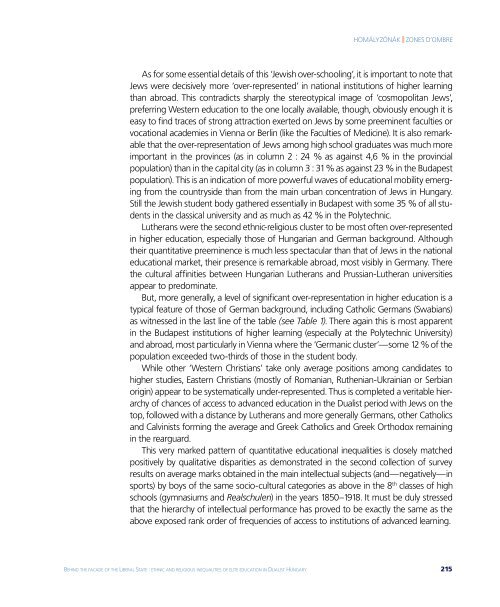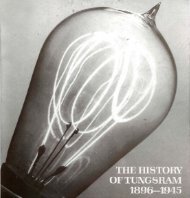- Page 1 and 2:
HOMÁLYZÓNÁKFELVILÁGOSODÁS ÉS
- Page 4 and 5:
Tartalom || Table des matièresElő
- Page 6 and 7:
Zi rku l i Pé terAt til a PókPau
- Page 8 and 9:
ElőszóAvant-proposMinden könyvne
- Page 10 and 11:
A többi már, mondhatni, mellékes
- Page 12 and 13:
Vaszary János hazatért Párizsbó
- Page 14 and 15:
országon, akár úgy, hogy azt jó
- Page 16 and 17:
Le destin des Juifs viennois : du B
- Page 18 and 19:
kanal), ce qui avait renforcé chez
- Page 20 and 21:
En l’absence d’autres documents
- Page 22 and 23:
dont la famille s’était établie
- Page 24 and 25:
à Oppenheimer 3 millions de florin
- Page 26 and 27:
En 1700, Samuel Oppenheimer eut bea
- Page 28 and 29:
lait sincèrement améliorer leur s
- Page 30 and 31:
kala ) dans les communautés juives
- Page 32 and 33:
ConclusionL’antisémitisme était
- Page 34 and 35:
mais dont les sectes et les orthodo
- Page 36 and 37:
prédécesseur dont nous reprenons
- Page 38 and 39:
que de Lwów 29 et publiée dans ce
- Page 40 and 41:
vaincu avec la croix. Un autre comb
- Page 42 and 43:
mud, les rabbins, que l’auteur qu
- Page 44 and 45:
9 juillet 1752, une lettre à son c
- Page 46 and 47:
„Úgy tűnik, hogy a magyarok, ki
- Page 48 and 49:
A huszárezredekben tehát kezdetek
- Page 50 and 51:
emlékiratai első könyvében ör
- Page 52 and 53:
szentpétervári udvarában. A cár
- Page 54 and 55:
Pécs, Ruszt, (Kis)Szeben, Székesf
- Page 56 and 57:
polgár” - Borsi-Kálmán Béla t
- Page 58 and 59:
a felvidéki anyakönyveket lehetet
- Page 60 and 61:
KÖZPÁLYÁJA 1773: a szerzetesrend
- Page 62 and 63:
Kal márffyra és címerlevele: Poz
- Page 64 and 65:
BIRTOKAI 1791: Buda egyik leggazdag
- Page 66 and 67:
III. 7. O. János újvidéki tanác
- Page 68 and 69:
mal és Fratricsievics Fülöppel v
- Page 70 and 71:
ForrásokLevéltárakKönyvtári gy
- Page 72 and 73:
Habermann Gusztáv 1992: Személyi
- Page 74 and 75:
Vármegyei tisztújítások, követ
- Page 76 and 77:
endszeresen jelentéseket küldött
- Page 78 and 79:
zására elvileg a vármegyei rendf
- Page 80 and 81:
koncentráltan került sor, ahol en
- Page 82 and 83:
Molnár András 2011: Deák Ferenc
- Page 84 and 85:
Közhangulat és konfliktusok Náda
- Page 86 and 87:
zsidó boltjából reá rohan, nyak
- Page 88 and 89:
„April 12én Höller, nádasi seb
- Page 90 and 91:
előtt hazugnak neveztem, miután c
- Page 92 and 93:
„…én [mármint Dusinszki] lát
- Page 94 and 95:
pázó vallomásos levelet írt Esz
- Page 96 and 97:
hírére, mint főnöke. Jobban is
- Page 98 and 99:
mek cinkoskodásának - mosolygásb
- Page 100 and 101:
1843) - a Pesti Hírlap-ban közöl
- Page 102 and 103:
emberi jog; ezt fejezi ki az első
- Page 104 and 105:
ten, ahol a vendégségbe meghívot
- Page 106 and 107:
vagyok született magyar, s csupán
- Page 108 and 109:
I. A jog.A jog az Istené.(Mózes V
- Page 110 and 111:
férfiak, kik az egyesületet alak
- Page 112 and 113:
Au milieu des graves préoccupation
- Page 114 and 115:
tényezője, s miszerint ez utolsó
- Page 116 and 117:
Dokumentumok a magyarországi zsid
- Page 118 and 119:
tervezte lebonyolítani az adatgyű
- Page 120 and 121:
a reményt (utóbbit illetően ld.
- Page 122 and 123:
kedni, hogy a táblázatok egy egy
- Page 124 and 125:
III.[A makói izraelita hitközség
- Page 126 and 127:
4. fi-osztályban azonban f. é. M
- Page 128 and 129:
V.[Gróf Dessewffy Emilnek, a Magya
- Page 130 and 131:
Szalay Márta - Nemes Erzsébet 200
- Page 132 and 133:
vezett, mely kapcsolatba van hozva
- Page 134 and 135:
3-án közöltét is, de láthatóa
- Page 136 and 137:
támogatását élvező lapok eset
- Page 138 and 139:
meggyőződésem, hogy az általa e
- Page 140 and 141:
a betelepüléstől számított hú
- Page 142 and 143:
Csetényi Imre, dr. 1942-1945: A ha
- Page 144 and 145:
ténetben, még ha megítélésébe
- Page 146 and 147:
1. térkép:A tiszalökiválasztók
- Page 148 and 149:
(talán egy Andrássy), de ebből n
- Page 150 and 151:
a 40 ezer liter kortesborból is a
- Page 152 and 153:
A választási eredménnyel szemben
- Page 154 and 155:
Jogegyenlőség és kirekesztés v
- Page 156 and 157:
nem zetiségi polgárháborúk magy
- Page 158 and 159:
intézményekkel és a társadalom
- Page 160 and 161:
forma és politikai forma megvan, m
- Page 162 and 163:
az is, hogy Széchenyit romantikusn
- Page 164 and 165: „Nemzeti konszolidációnk nem k
- Page 166 and 167: a magyarságot a nemzetiségi vidé
- Page 168 and 169: V.A jogkiterjesztéssel szemben meg
- Page 170 and 171: a demokrácia úgy hozható összha
- Page 172 and 173: VII.Schvarcz Gyula a liberalizmust
- Page 174 and 175: Beksics Gusztáv írásaiból csak
- Page 176 and 177: Dénes Iván Zoltán 2011b: Az „i
- Page 178 and 179: Szabad György 1967: Forradalom és
- Page 180 and 181: e, amelyek kevéssé sértették az
- Page 182 and 183: üzletember, Henri Moser (1844-1923
- Page 184 and 185: lyesen kiválasztott és kedvelt Il
- Page 186 and 187: a nagyobb hatás érdekében ne rag
- Page 188 and 189: képsorozat tematikus tervét. Pont
- Page 190 and 191: lágkiállítási megbízással elh
- Page 192 and 193: Moser, Henri 1885: À travers l’A
- Page 194 and 195: (1916. április 1.), 6 majd - bizon
- Page 196 and 197: magyarázni eljárását a Kőnig-l
- Page 198 and 199: A borítékon:Ung[arn]Herrn Georges
- Page 200 and 201: K[rén] K[atalin] 1974: Romain Roll
- Page 202 and 203: a németet, 5 szinte anyanyelvi szi
- Page 204 and 205: megélhetési költségek miatt. Ne
- Page 206 and 207: szakban elérte az 1071-et. 22 (Mí
- Page 208 and 209: Karády Viktor kutatásaiból ismer
- Page 210 and 211: Karády Viktor 1992: Egyetemi antis
- Page 212 and 213: Behind the facade of the Liberal St
- Page 216 and 217: Table 2:Average marks 9RELIGION SUR
- Page 218 and 219: As for sports, the hierarchy appear
- Page 220 and 221: Gólúsz, geullaFilep Ta m á s Gu
- Page 222 and 223: ius templomban tartott prédikáci
- Page 224 and 225: HOtel Savoy de Joseph Roth 1L’Ori
- Page 226 and 227: hôtel et ils croyaient que leur ma
- Page 228 and 229: ses nues et même la mort de Santsc
- Page 230 and 231: Tudósítás a könyvtárból: Koes
- Page 232 and 233: II.A hangzásról pedig a megértő
- Page 234 and 235: László szavaival: „Koestler azt
- Page 236 and 237: érdekében (Camus-vel, angol bará
- Page 238 and 239: Souverenität und zuletzt die sehr
- Page 240 and 241: Vernichtung des „Rückgrates“ d
- Page 242 and 243: Politikern von der ungarischen jüd
- Page 244 and 245: geändert, und die Funktion des Sta
- Page 246 and 247: Cultures et crises politiques en Eu
- Page 248 and 249: devint du 7 décembre 1954 au 14 no
- Page 250 and 251: passaient à l’Ouest. Cette circu
- Page 252 and 253: naissance morale ou politique mais
- Page 254 and 255: sorból való megszabadulás után?
- Page 256 and 257: közök, számítógépek, okostele
- Page 258 and 259: indokolhatatlan tömegpszichózissa
- Page 260 and 261: zást és konfliktusokat feltétele
- Page 262 and 263: en készült, illetve hogy a mester
- Page 264 and 265:
eleve különböző, alig összemé
- Page 266 and 267:
tust tárgyaló ugyancsak 2001-es c
- Page 268 and 269:
zásáról, máris megkaphatja, hog
- Page 270 and 271:
Istvánt. De nem teszi senki, nem t
- Page 272 and 273:
28c) vajon az, amit József Attila,
- Page 274 and 275:
kel van-e újfent dolgunk? Máskép
- Page 276 and 277:
Kende Péter 2003: Zsidó Magyarors
- Page 278 and 279:
giai fordítási hagyomány külön
- Page 280 and 281:
érvelésnek a szónoklat lényegé
- Page 282 and 283:
vitatkozásba döntenék? Ez a munk
- Page 284 and 285:
ereidnek, szinte félsz tőle, hogy
- Page 286 and 287:
Balogh József 2001a: A hangos olva
- Page 288 and 289:
emigránsokat. Az angolok ezt úgy
- Page 290 and 291:
emlékszem, hogy melyikünk hozta m
- Page 292 and 293:
La libéralisation en matière d’
- Page 294 and 295:
à Lucie Favier par ses collègues
- Page 296 and 297:
vis Extraneis. Series dedicata in m
- Page 298 and 299:
(Társszerző: Jean Bérenger) Orsz
- Page 300 and 301:
- interview de Charles Kecskeméti
- Page 302 and 303:
A szerzőkről || Sur les auteursB
- Page 304 and 305:
Gra dvoh l, Pau l (sz./né: 1957)Fo
- Page 306 and 307:
Pa j ko s s y Gá bo r (sz./né: 19
- Page 308:
A kiadásért felel a Sík Kiadó K








![Letöltés egy fájlban [4.3 MB - PDF]](https://img.yumpu.com/50159926/1/180x260/letaltacs-egy-fajlban-43-mb-pdf.jpg?quality=85)








